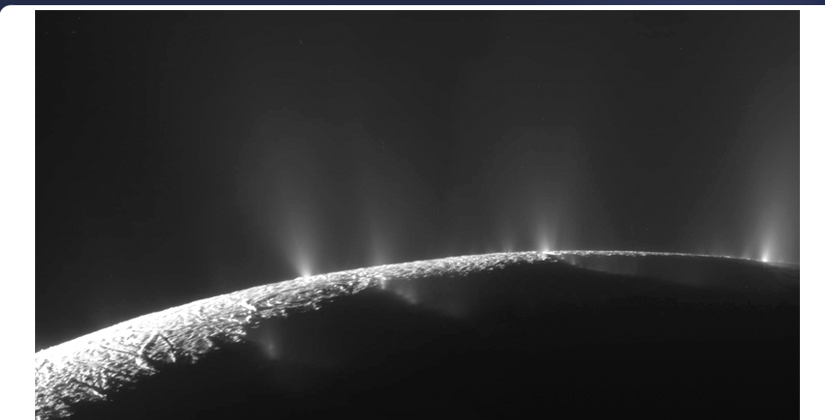




Resonant Standing Waves in the Atmosphere of Enceladus
Cassini Flyby Shows Enceladus Venting
Image Credit: NASA/JPL/SSI; Mosaic: Emily Lakdawalla
by Robert Nemiroff & Jerry Bonnell for Astronomy Picture Of the Day
November 24, 2009
Explanation: What's happening on the surface of Saturn's moon Enceladus? Enormous ice jets are erupting. Giant plumes of ice have been photographed in dramatic fashion by the robotic Cassini spacecraft during this past weekend's flyby of Saturn's moon Enceladus. Pictured above, numerous plumes are seen rising from long tiger-stripe canyons across Enceladus' craggy surface. Several ice jets are even visible in the shadowed region of crescent Enceladus as they reach high enough to scatter sunlight. Other plumes, near the top of the above image, appear visible just over the moon's sunlit edge. That Enceladus vents fountains of ice was first discovered on Cassini images in 2005, and has been under close study ever since. Continued study of the ice plumes may yield further clues as to whether underground oceans, candidates for containing life, exist on this distant ice world.
Analysis
The forces behind the giant ice crystal plumes of the geysers of Enceladus are unmistakable in this context due to the fact that the geysers are aligned in parallel rows! The water venting at these geyser sites is superheated by the intense infrasound resonance of Enceladus, which focuses the equatorial pull of Saturn into a north-south polar axis, heating the south polar region.
The ejected superhot water immediately forms fine ice crystals which are raised high above the surface as plumes along the wavepaths of standing infrasound (animated above). The individual geysers display a Fibonacci-ordered distribution pattern as measured along the 'tiger stripes' which reveals the driving presence of nonlinear standing waves, the exact frequencies of which may be determined by measuring the exact distances between the individual geysers.
This same phenomenon of infrasound stimulated water vapor plumes was also recently photograhged off the California coast at Aliso Beach. The infrasound standing wave resonance pattern based on the quantum iterated function [ zn+1 = zn2 ] are observable in galaxies, quasars, the solar corona and in the atmospheres of Earth, Jupiter, Uranus, Saturn and its moons Eceladus and Titan.